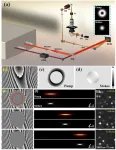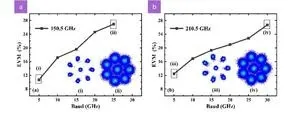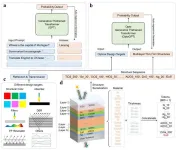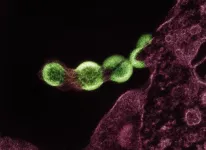A new publication from Opto-Electronic Advances; DOI 10.29026/oea.2024.240064, discusses advanced phase-controlled 3D biochemical imaging.
Three-dimensional (3D) imaging provides deep insights into understanding of complex biological and biomedical systems, which offers far more detailed information than traditional 2D methods. A standout in this field is nonlinear optical microscopy, particularly coherent Raman Scattering (CRS) microscopy (e.g., coherent anti-Stokes Raman scattering (CARS) and stimulated Raman scattering (SRS) microscopy). The CRS microscopy uses the intrinsic biomolecule vibrations in the samples to create images, opening a new window to study the intricate structures and molecular makeup of cells and tissues without needing to add any fluorescent labels, unveiling the dynamic and functional mechanisms and metabolic activities of intra- and extra -cellular molecules in live cells and tissue at the molecular level.
CARS microscopy was the first to be developed but faced challenges like distorted Raman spectra and sensitivity issue due to non-resonant background interference. SRS microscopy overcame these hurdles, enabling highly sensitive, quantitative biochemical imaging by avoiding non-resonant background interference. In recent years, SRS has been widely used in various fields, such as cancer diagnosis and characterization, tumor metabolisms, drug deliveries and pharmacodynamics, molecular genetics, organ functions, and developmental biology. In SRS, the two laser beams (pump and Stokes) are spatially and temporally combined and focused onto a sample. When their frequency difference matches the target molecule's vibration, coherent Raman scattering process will occur along the phase-matching direction, empowering SRS imaging with biomolecular contrast.
The authors of this article have developed an advanced SRS 3D microscopy called phase-controlled SRS (PC-SRS). This new technique allows for rapid and deep tissue 3D chemical imaging without the need for mechanical z-scanning. PC-SRS uses unique imaging system designs with the combination of ring-shaped pump beam and Gaussian Stokes beam (Fig. 1a), and the incorporation of Zernike polynomials (ZPs) in Fig. 1(b-d). These designs allow for the precise engineering of the Bessel beam’s length and the corrections of the imaging system aberrations in both beams. PC-SRS possess a high signal-to-noise ratio (SNR) after compressing the length of Bessel beam and correcting the distortions for each beam. By electronically tuning phase patterns on the spatial light modulator (SLM), they can control the beam positions axially within the tissue, enabling 3D imaging even in thick samples (Fig. 1e-g).
PC-SRS has shown significant improvements in imaging speed and depth. For example, it can monitor the Brownian motions of polymer beads in water at high speeds (77 ms intervals, 13 Hz volume rate), and it offers deeper imaging capabilities in highly scattering media like brain tissue. Using scattering-resilient Bessel pump beam and longer wavelength Stokes beam (1041 nm in the NIR-II window), PC-SRS achieved about double the imaging depth compared to conventional SRS technique. Additionally, the authors used PC-SRS to study metabolic activities of liver tumor in living zebrafish. By tracking the formation of C–D bonds in macromolecules synthesized during cellular metabolic activities, they observed higher metabolic activity in tumor tissues compared to normal ones. The rapid depth-resolved imaging capabilities of PC-SRS allowed them to unravel how metabolic activity varied at different tissue depths, i.e., a highly active metabolism being observed in shallower liver regions compared to the deeper areas in liver tumor.
The authors believe that PC-SRS holds great promise for real-time monitoring of live cells and tissues, facilitating the transformation of the understandings of their metabolic and dynamic processes in live cells and tissue into the fields like cancer research, drug delivery, and developmental biology.
Keywords: SRS 3D imaging / phase-controlled light focusing / image aberration corrections / deep tissue imaging
# # # # # #
Prof. Zhiwei Huang is Director of Optical Bioimaging Laboratory in the Department of Biomedical Engineering, College of Design and Engineering at the National University of Singapore. He is a world-renowned expert in biomedical optics, biophotonics and microscopy imaging. His major research areas are in the fields of biomedical optics, microscopy, Raman spectroscopy and imaging, particularly centering on the development of super-resolution microscopy and nonlinear optical microscopy imaging techniques (e.g., coherent Raman scattering microscopy, multiphoton microscopy) and their applications in biomolecular imaging, as well as the development of novel fiber-optic Raman spectroscopy and endoscopic imaging, enabling early diagnosis and detection of epithelial precancer and cancer at endoscopy. He pioneered in Raman endoscopy and label-free super-resolution bioimaging technologies, and published over 130 peer-reviewed articles in leading journals (e.g., Nature Photonics, Gastroenterology, etc), and delivered over 100 plenary/keynote/invited lectures worldwide. He has filed over 20 US patents with 10 licensed for commercialization. His IMDX technique invented was ranked No.1 among the top 10 medical devices listed in Medica, Germany. He is Elective Fellow of SPIE- the international society for optics and photonics.
# # # # # #
Opto-Electronic Advances (OEA) is a rapidly growing high-impact, open access, peer reviewed monthly SCI journal with an impact factor of 15.3 (Journal Citation Reports for IF2023). OEA has been indexed in SCI, EI, DOAJ, Scopus, CA and ICI databases, and expanded its Editorial Board to 31 members from 17 countries with an average h-index of 62.
The journal is published by The Institute of Optics and Electronics, Chinese Academy of Sciences, aiming at providing a platform for researchers, academicians, professionals, practitioners, and students to impart and share knowledge in the form of high quality empirical and theoretical research papers covering the topics of optics, photonics and optoelectronics.
# # # # # #
More information: http://www.oejournal.org/oea
Editorial Board: http://www.oejournal.org/oea/editorialboard/list
All issues available in the online archive (http://www.oejournal.org/oea/archive).
Submissions to OEA may be made using ScholarOne (https://mc03.manuscriptcentral.com/oea).
ISSN: 2096-4579
CN: 51-1781/TN
Contact Us: oea@ioe.ac.cn
Twitter: @OptoElectronAdv (https://twitter.com/OptoElectronAdv?lang=en)
WeChat: OE_Journal
# # # # # #
Wang WQ, Huang ZW. Stimulated Raman scattering microscopy with phase-controlled light focusing and aberration correction for rapid and label-free, volumetric deep tissue imaging. Opto-Electron Adv 7, 240064 (2024). doi: 10.29026/oea.2024.240064
END






